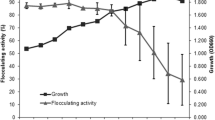Summary
Physiological studies on Bacillus thuringiensis var. entomocidus revealed the failure of the organism to survive or sporulate under low aeration levels, notably in the presence of high sugar concentrations. Cell counts, sporulation titers and potency of resulting endotoxin were found to vary with the level of aeration. The incremental feeding of glucose with continuous pH adjustment prevented cell injury and death which results from prolonged exposure to acidity liberated at the high sugar concentrations which occur when glucose is added batchwise. Increasing of dipotassium phosphate concentration in growth medium increased the potency of the resulting endotoxin.
Similar content being viewed by others
References
Dulmage HT, Correa JA, Martinez AJ (1970) Coprecipitation with lactose as a means of recovering the spore-crystal complex of Bacillus thuringiensis. J Invertebr Path 15:15–20
Dulmage HT, Boening O, Rehenborg C, Hansen G (1971) A proposed standardized bioassay for formulations of Bacillus thuringiensis based on the international unit. J Invertebr Path 18:240–245
Salama HS (1970) Rearing the corn borer Ostrinia nubilalis Hubn. on a semiartificial deit. Zeit Angew Ent 65:216–218
Salama HS, Foda MS (1982) A strain of Bacillus thuringiensis var. entomocidus with high potential activity on Spodoptera littoralis. J Invertebr Path 39:110–111
Salama HS, Foda MS, Sharaby A (1983) Utilization of fodder yeast and agroindustrial byproducts in production of spores and biologically-active endotoxins form Bacillus thuringiensis. Zbl Mikrobiol 138:553–563
Wakisaka W, Masaki E, Nishimoto Y (1982) Formation of crystalline δ-endotoxin or poly-B-hydroxybutyric acid granules by asporogenous mutants of Bacillus thuringiensis. Appl and Environ Microbiol 43
Author information
Authors and Affiliations
Rights and permissions
About this article
Cite this article
Foda, M.S., Salama, H.S. & Selim, M. Factors affecting growth physiology of Bacillus thuringiensis . Appl Microbiol Biotechnol 22, 50–52 (1985). https://doi.org/10.1007/BF00252156
Received:
Revised:
Issue Date:
DOI: https://doi.org/10.1007/BF00252156




